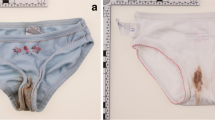Abstract
Child Sexual Abuse is an alarming reality and is being increasingly reportedin India as well as globally. Pediatricians and allied medical professionals are often the first point of contact with abused children and their families. They have a key role in detecting Child Sexual Abuse, providing immediate and long-term care and support to the victims and their families. India has adopted the Protection of Children from Sexual Offences Act (POCSO) in 2012. It is a comprehensive law on sexual abuse, which expands the scope and range of forms of sexual offences, makes reporting of abuse mandatory and defines guidelines for the examination of victims. Pediatricians and health care professionals need to acquire necessary expertise for clinical evaluation of child sexual abuse, and its prevention, management and reporting.
Similar content being viewed by others
References
Bhave S, Saxena A. Child sexual abuse in India. In: Srivastava RN, Seth R, Van Niekerk J, editors. Child Abuse and Neglect: Challenges and Opportunities. New Delhi: Jaypee Brothers, 2013.p.62–70.
The Protection of Children from Sexual Offences Act 2012. Available from:wcd.nic.in/childact/child protection31072012.pdf. Accessed May 30, 2017.
Roylance R, Foley S, Manzel K. International perspectives on child sexual abuse. In: Srivastava RN, Seth R, Van Niekerk J, editors. Child Abuse and Neglect: Challenges and Opportunities. New Delhi: Jaypee Brothers, 2013. p.40–50.
Wihbey J. Global Prevalence of Child Sexual Abuse, 2013. Available from: Journalistresource.org/studies/./globalprevalence-child-sexual-abuse.Accessed May 30, 2017.
Study on Child Abuse: India (2007). Ministry of Women and Child Development, Government of India.Available from:www.wcd.nic.in/childabuse.pdf. Accessed May 30, 2017.
Cashmore J, Shackel R. The Long Term Effects of Child Sexual Abuse. Child Family Community Australia, 2013, Paper No 11.
Finkel MA. Medical evaluation of child sexual abuse. In: Srivastava RN, Seth R, Van Niekerk J, editors. Child Abuse and Neglect: Challenges and Opportunities. New Delhi: Jaypee Brothers, 2013.p.62–70.
Finkel MA. The Evaluation. In: Finkel MA, Giardino AP, editors. Medical Evaluation of Child Sexual Abuse: A Practical Guide. 3rd ed. Elk Grove Village, IL: American Academy of Pediatrics. 2009.p.19–52.
UNICEF and Indian Medical Association. Child Sexual Abuse: Prevention and Response. Information for Doctors and Health Care Professionals (2015).
Guidelines and Protocols. Medicolegal Care of Survivors/Victims of Sexual Violence, 2014. Available from: http://mohfw.nic.in. Accessed May 30, 2017.
Ministry of Women and Child Development. One Stop Centres. Available from: www.wcdhry.gov.in/oscg.pdf. Accessed September 7, 2017.
World Health Organization. Responding to children who have been sexually abused. WHO Clinical Guidelines. Geneva: World Health Organization, 2017.
Author information
Authors and Affiliations
Corresponding author
Rights and permissions
About this article
Cite this article
Seth, R., Srivastava, R.N. Child Sexual Abuse: Management and prevention, and protection of children from Sexual Offences (POCSO) Act. Indian Pediatr 54, 949–953 (2017). https://doi.org/10.1007/s13312-017-1189-9
Received:
Revised:
Accepted:
Published:
Issue Date:
DOI: https://doi.org/10.1007/s13312-017-1189-9




